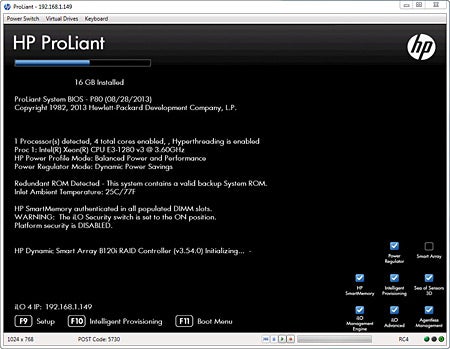HP’s Gen8 servers include two offerings on the low end: the ProLiant MicroServer (reviewed in July) and the 1U ProLiant DL320e.
The ProLiant MicroServer works well as a file/print server and includes all the high-end HP management tools you’ll find on the more expensive models. It has a small footprint and could be tucked away on or under a desk or in a closet. The ProLiant DL320e, on the other hand, is meant to be installed in a common 19-inch rack but doesn’t take up much space.
It has some features in common with the MicroServer model, like the full-blown HP iLO management suite with a dedicated Ethernet port plus two additional Ethernet ports for all other traffic. It also includes the B120i Smart RAID controller but has only two disks to control. Our review unit came with two 1TB SATA drives installed and configured in RAID 0, which means no protection by default.
Hardware Details
One big difference between the two systems is memory capacity. The DL320e has four DIMM slots, so you can install 32 GB of memory with four 8 GB as opposed to the MicroServer which has only two slots. Our review unit came with two 8 GB DIMMs installed, which was double the amount in the MicroServer review unit. Available memory is a big deal if you plan on running a server operating system or a virtualization host.
The second major difference is in CPU horsepower. The review MicroServer came with an Intel Core i3-3220T, while the DL320e packs a Xeon E3-1280.
Based on the scores from cpubenchmark.net, the DL-320e has almost four times the compute power of the MicroServer (10110 vs 3706 average CPU mark). That’s a significant difference on the processing front, but it does give the indication that the two systems might work well together with one as more of a storage device and the other as a compute platform.
The chassis construction draws on the traditional HP ProLiant design heritage with lots of attention to detail. On the rear panel (See Figure 1) you’ll find the three Ethernet ports, two USB 2.0 ports for a keyboard and mouse, a standard VGA monitor connector and two USB 3.0 ports.

Figure 1
On the front you’ll see two removable 2.5 inch disk drives, two USB 2.0 ports and the power switch (See Figure 2). Our unit didn’t come with a DVD drive, but it is available as an option. Another option is a four-bay small form factor (SFF) hot-plug disk drive cage to expand storage.

Figure 2
Two internal PCIe slots provide support for a single 16X Gen3 (8x speed) half-length, full-height card and one PCIe 8x Gen3 (4X speed) low-profile card. We were able to install a Mellanox ConnectX-3 10 GB Ethernet adapter card in under five minutes.
Another internal USB 2.0 port supports booting from flash for VMware ESXi. HP provides a custom VMware ESXi image with all required drivers pre-installed. Popping the lid on the DL 320e reveals the HP engineering prowess including fans, easy access to the memory slots and a nice schematic diagram on the inside of the cover.
Software and Management
To test loading software we first installed Windows Server 2012 on the DL320e with no issues encountered. We then tried Windows 2012 R2 Hyper-V Server. At the time this was written HP had not officially announced full support for the latest Windows Server releases.
We did experience several issues, including a blue screen crash, with our initial install but were able to get them resolved by first installing Windows 2012 Hyper-V Server and then accomplishing an in-place upgrade. HP has a tech note describing a workaround for an issue with the RAID controller.
The DL320e ships with a version of the basic iLO management software that works fine for most small installations. However, to get the full remote console capability you will need to upgrade to either HP iLO Essentials or HP iLO Advanced.
The base price for HP iLO Essentials with one year of tech support is $129 for a single server. Discounts are available for multiple server purchases. The remote console will work to install an operating system, but that’s all. Figure 3 shows the boot screen.
The Web-based iLO management console looks much the same as all other HP business-class servers. Figure 4 shows the basic iLO screen with an overview of all pertinent system information and quick links to other setup functions. The Virtual Media tab allows you to connect remote resources like a physical DVD or .iso file and make them appear to the system as local. This feature also requires one of the paid-for licenses.
Bottom Line
Prices start at $949 for a low-end model with 8GB of memory, an Intel Xeon E3-1240 v2 processor and space for four SATA disks. While that’s not as cheap as the MicroServer, you definitely get more capability with the DL320e. As mentioned earlier, it would make a great companion to the ProLiant MicroServer to provide compute and storage for a small business or small branch office.
Paul Ferrill, based in Chelsea, Alabama, has been writing about computers and software for almost 20 years. He has programmed in more languages than he cares to count, but now leans toward Visual Basic and C#.



